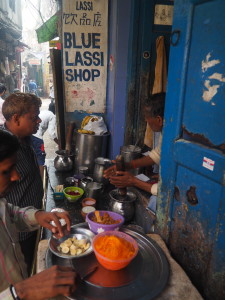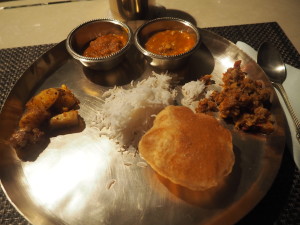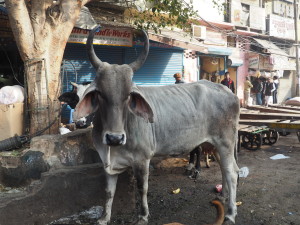
For most people, eating in India conjures images of fragrant curries and tandoori breads. But it also brings on fears of “Delhi Belly” due to let’s say “different” hygiene standards as well as the challenges of navigating unfamiliar menus. After a recent jaunt to the subcontinent, I’m ready to share some tips to help make eating out in India an easy and enjoyable experience. Here’s what you need to know:
First off, India is a vegetarian’s paradise. As much as 40% of the population refrains from meat so you can expect at least half (if not all) the menu dedicated to veggie delights. There’s plenty of potatoes, carrots, peas, spinach, onions and cheese in fried, curry and tandoori oven cooked forms.
For meat lovers, options are a bit more limited. Firstly, cows and pigs are considered holy and rarely appear on menus (in the streets is a different matter…) If meat is on offer, it’s typically chicken or lamb. However, these are also probably the most common source of Delhi Belly. So go with your gut (while it’s in tact) to determine whether the place seems sanitary. I ended up eating vegetarian about 90% of the time with minimal grumblings from my inner carnivore.
Street food is the other potential cause for concern. Basically my rules are: stick to places that look busy and only order food cooked in front of you (really no different than for halal carts in New York). If you follow these practices, you’ll likely be safe eating off the streets anywhere in the world.
On to the food. Below are some of my favorite dishes from the trip should you need a little inspiration on what to order:
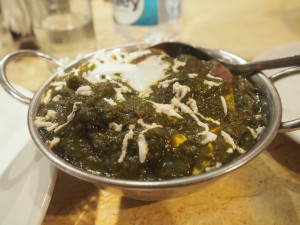 Saag (or Palak) Paneer A healthier alternative to most curries, there’s generally less if any cream used as the base is primarily pureed spinach and onion. The addition of paneer (a soft, mild Indian cheese) adds a nice texture. And of course cheese makes everything better.
Saag (or Palak) Paneer A healthier alternative to most curries, there’s generally less if any cream used as the base is primarily pureed spinach and onion. The addition of paneer (a soft, mild Indian cheese) adds a nice texture. And of course cheese makes everything better.
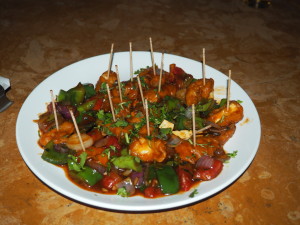 Chilli (or Chilly) Paneer A Chinese influenced dish that’s served basically fried cheese, onions and peppers in a sauce similar to Chinese Garlic Sauce. It’s a nice alternative when you get tired of curry but don’t want to chance the Indian “interpretation” of chicken alfredo.
Chilli (or Chilly) Paneer A Chinese influenced dish that’s served basically fried cheese, onions and peppers in a sauce similar to Chinese Garlic Sauce. It’s a nice alternative when you get tired of curry but don’t want to chance the Indian “interpretation” of chicken alfredo.
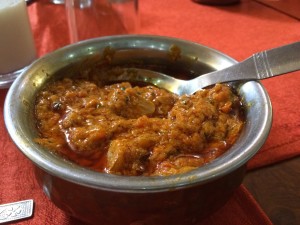 Gatta Curry A specialty of Rajasthan in Northwest India, gatta are balls of chickpea flour similar to gnocci, shown here in a cashew and tomato based curry. I’ve yet to see this in America so be sure to give it a try when you’re over there.
Gatta Curry A specialty of Rajasthan in Northwest India, gatta are balls of chickpea flour similar to gnocci, shown here in a cashew and tomato based curry. I’ve yet to see this in America so be sure to give it a try when you’re over there.
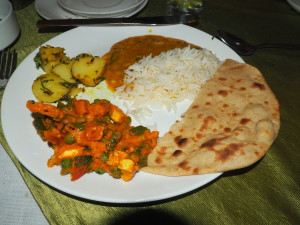 Above are a few other solid veggie options : aloo dum (potato fry), mixed vegetable curry and dal (soupy lentils) with rice and chapati bread (similar to naan but without butter or yeast).
Above are a few other solid veggie options : aloo dum (potato fry), mixed vegetable curry and dal (soupy lentils) with rice and chapati bread (similar to naan but without butter or yeast).
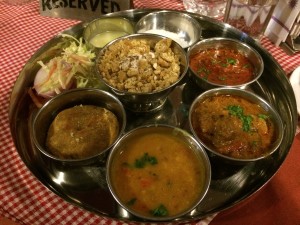 Thali For those who can’t decide, there’s thali. Think of it as a mini tasting menu. These usually come with bread, rice, at least two to three types of curry, yogurt and a dessert.
Thali For those who can’t decide, there’s thali. Think of it as a mini tasting menu. These usually come with bread, rice, at least two to three types of curry, yogurt and a dessert.
Chicken Kadai (or Karahi) When I did opt for meat, this was my staple (yet I somehow managed to end up without a photo). It comes in a cashew nut gravy and is one of the few curries served with bell peppers. Topping it with cilantro ensured I’d be ordering it again.
Masala Chai You’ll find this all over India and if you’re a fan of what we call chai (which just means “tea” in India), you’re in for a treat. Unlike in America where spice packets are commonly used, here they do it the old fashioned way: freshly grinding the spices (cardamom, ginger and pepper). It’s served with a generous helping of milk and sugar.
Lassis
Lassis are basically the Indian milkshake combining salty yogurt with a variety of fruits. At many restaurants I found the sour-salty yogurt over powering and shied away. However, there were two places you must get lassis if you’re in the respective city:
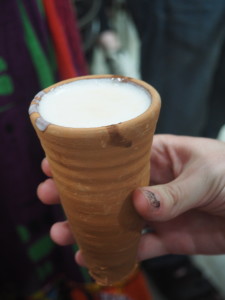 Lassiwalla in Jaipur prepares a creamier lassi without the salty sour flavor. It’s more like really good milk shake, but lighter thanks to the use of yogurt. Mine was mango and came in this photogenic clay cup.
Lassiwalla in Jaipur prepares a creamier lassi without the salty sour flavor. It’s more like really good milk shake, but lighter thanks to the use of yogurt. Mine was mango and came in this photogenic clay cup.
 Blue Lassi in Varanasi not only rhymes but is considered by many the top lassi shop in India. The lassis here are more parfait style with fresh fruit chopped and put on top of a bowl of yogurt. For those looking to take their yogurt to new “highs” there are special versions available.
Blue Lassi in Varanasi not only rhymes but is considered by many the top lassi shop in India. The lassis here are more parfait style with fresh fruit chopped and put on top of a bowl of yogurt. For those looking to take their yogurt to new “highs” there are special versions available.
Sweets
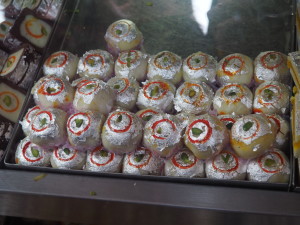
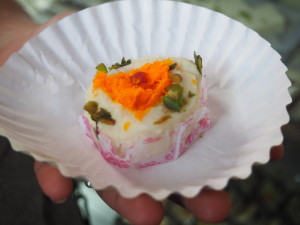
 In nearly every city you’ll find cases filled with delectable white sweets. They’re heavy on both the sugar and cream which gives them sort of a tres leches flavor. Some are mixed with coconut or chocolate. The shiny stuff in the top photo is actually edible silver. Unfortunately due to the milk content they need to be eaten within 24 hours so you won’t get to take any home. Not that they would last that long anyway.
In nearly every city you’ll find cases filled with delectable white sweets. They’re heavy on both the sugar and cream which gives them sort of a tres leches flavor. Some are mixed with coconut or chocolate. The shiny stuff in the top photo is actually edible silver. Unfortunately due to the milk content they need to be eaten within 24 hours so you won’t get to take any home. Not that they would last that long anyway.
Old Delhi Walking Tour with MJH Tourism
I highly recommend this tour for anyone with some time in Delhi. While it isn’t entirely food related, you do eat some great food while seeing things and meeting people you never would on your own. You can get more details and book it here.
We started off with breakfast of a chana masala (spiced chickpeas) with poori. Think of Poori as an edible bread balloon. It’s a fried Indian bread that inflates with air when cooked which you then squash and rip up to eat. As you can see, I got to make my own.
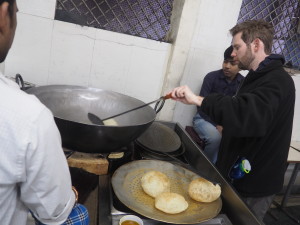
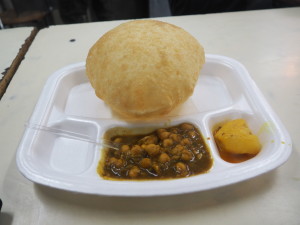 The tour also included (among other things) a walk through the spice market at Khari Baoli where you can pick up all you Indian spice needs on the cheap. We ended at our guide Dhruv’s beautifully restored haveli (old mansion) where his wife prepared the meal for us below. Indian home cooked meals vary quite a bit from what you find at restaurants. Depending on how charming you are, you probably won’t have too many opportunities to get one on your trip (this was my only one). Which is yet another reason I recommend this tour.
The tour also included (among other things) a walk through the spice market at Khari Baoli where you can pick up all you Indian spice needs on the cheap. We ended at our guide Dhruv’s beautifully restored haveli (old mansion) where his wife prepared the meal for us below. Indian home cooked meals vary quite a bit from what you find at restaurants. Depending on how charming you are, you probably won’t have too many opportunities to get one on your trip (this was my only one). Which is yet another reason I recommend this tour.

